
When you first open Modo after installing it, this is the interface you're presented with. It was designed and refined over multiple versions for the smoothest user experience. Users of any previous version on Modo are very familiar with this tabbed version of the interface, where each focused workspace is selected directly using the tabs across the viewport. If your viewport doesn't match the one displayed below, you can select the matching interface from the menu bar under Layout > Layouts > Tabbed. Each of the workspaces are set up as three main sections. The left side column is for tools and commands, the center viewport is the most frequently used in Modo, and lastly, the right-hand side houses information regarding the scene: its many items and their respective attributes. Understanding all the various areas and their roles in working in Modo is essential to getting the most out of it. Hover over the image below to see the interface sections highlighted, click to jump to the different areas for more detail.
![]()
Any function of Modo is available from the menu bar, organized by their respective application. Clicking on any of the menu bar items reveals the menu itself, a list of commands that sometimes activates a tool that requires further action within the 3D Viewport (Section 6), or sometimes initiates a pop-up window requesting additional input. Most of the functions within the menu bar are repeated elsewhere within the application as a button, or are available via Modo's many keyboard shortcuts, listed to the right of the menu item (for a list of Modo keyboard shortcuts, see Appendix A: Keyboard Shortcuts). This functional duplication enhances overall workflow.
![]()
Directly below the menu bar is the switcher bar. Each tab in the switcher bar represents a focused workspace, optimized for their specific task. Left mouse button clicking on a tab opens that particular layout. Users can add their own layouts using the plus icon located to the right of the last tab. Once created an additional tab is added to the right most position of the bar. Tabs can be reordered by click holding a tab and dragging it to a new location. The drop position will be indicated by a small orange line. The star on each tab allows users to highlight specific, often used tabs. When the Star Only button is pressed, all the unstarred tabs will be suppressed from display. Layouts can be reset to their initial default states by double clicking on a specific tab, opening a requester asking if you are sure you want to reset the display. To minimize the display, click the two upward facing arrows on the far left, temporarily hiding it. To reopen it, click over the remaining small line.
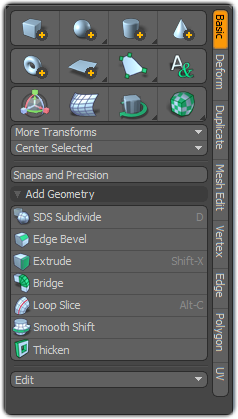
The Toolbox section resides in the upper area of the left-hand side of the screen. Nearly every interface tab has its own particular dedicated toolbox, illustrated here with the Model tab's Toolbox. The Toolbox itself houses the various tools and commands. On the right side of the Toolbox, there are a series of rotated tabs or sub-sections (referred to as sub-tabs) that organize the various tools by their function. Clicking on any of the tool icons activates the tool for use within the 3D Viewport. The active tool is highlighted in orange. Most tools function interactively with clicking and dragging within the 3D Viewport (section 6). Some tools can be modified by Ctrl/Cmd, Alt and Shift keys on the keyboard with some tools supporting additional functions for the middle and right mouse buttons. Depending on the tool's function, its properties appear in the section directly below, where settings can be modified and applied. A tool can be dropped (deactivated) by pressing Q or the space bar, or by selecting another tool. Buttons to quickly access alternate toolboxes are available just above the toolbox.
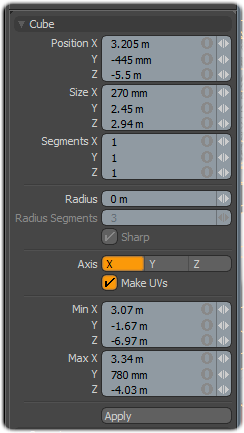
Directly below the toolbox are the properties dedicated to the currently active tool, in this case the Cube tool. Tool properties only appear when a tool is activate, and they change depending on which tool is selected. For most tools, you can interactively click and drag in the viewport, and see the properties themselves update in real time. Conversely, you can directly edit the properties by clicking over a value in the light gray area and typing in a new value. Hit Enter to see the update in the viewport.
TIP: The Tab key can be used to jump between value input fields eliminating the need to click over each field.
Once you are satisfied with your settings, drop the tool by pressing Q or hitting the space bar to freeze those particular settings. You can also activate a tool, and enter values directly into the properties panel but you need to press the Apply button to see their effect, losing any interactive editing functionality. By clicking in a 3D Viewport while a tool is active, you are placing Modo into an interactive mode, where Apply becomes unnecessary.

The Modes section appears under the menu bar and above the 3D Viewport. The first three buttons from the left are the component editing modes, an important distinction in Modo. These modes set how one selects and works directly with geometry for manipulation: pushing, pulling and modifying polygons. You can toggle between any of these modes by pressing the space bar, continuously looping through the three, or by pressing the number indicated next to the name of each component (1, 2 or 3) on the keyboard.
The fourth button, Items mode is for editing items. To understand the difference between Component modes and Item mode, think of each item layer as a container: the Component modes edit what's inside the container, and Item mode edits the container itself. A separate Item mode is necessary for some functions in Modo. For example, when animating, you are transforming items (the containers), and individual vertices are not directly animateable. Also, Replicators, and instances work by duplicating the container.
If you click and hold the Items mode button, a pop-up reveals additional material selection modes. You can select an item's Center and Pivot points. These are the defined surfaces within the Shader Tree, which is the heart of Modo's shading system. The rest of the buttons are modifiers for tools, changing their basic behaviors. Action Centers are useful, because they can automatically adjust a tool's axis and orientation. Symmetry duplicates manipulations across an axis. Falloff controls the effect a tool has on a selection based on an interactively applied distance. Snapping can ease certain workflows that require levels of precision and lastly the Work Plane is an interactive and modifiable virtual workbench within Modo that simplifies many modeling tasks among other things. For more information on these controls, see System and Files.
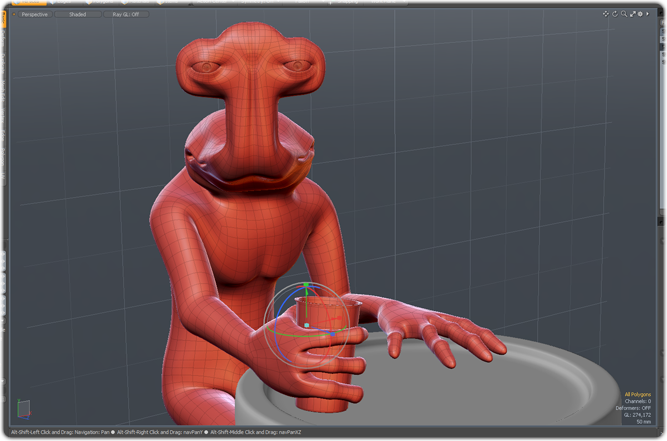
The 3D Viewport is the most frequently used interface in Modo. It contains a dark grid going off into the distance. This is the ground plane, denoting the zero position of the Y axis. As items move up, they increase their Y position value.
NOTE: The Y axis is also referred to as the Up axis.
The X values move from left to right, and the Z axis (depth) moves from front to back. (If you are used to an alternate up axis, you can modify the setting in System > Preferences) The darkest lines represent zero for the X and Z planes, the origin is where all three axes intersect, '0,0,0' on all three axes. Item level transforms all take place from this position.
You can navigate in the viewport using the three icons in the upper right-hand corner. Clicking and dragging over the four arrows icon moves the viewpoint position, the rotation icon rotates the view and the magnifying glass icon scales it. There are also keyboard shortcuts for viewport navigation, making for easier navigation. Press Shift+Alt and then click and drag over the viewport to move the view position around. Middle-click to move the view forwards and backwards, and right-click to restrict the view change to up and down. To rotate the viewpoint, press Alt and click and drag over the viewport. Middle-click and dragging restricts the rotation around the Y axis, and right-click and dragging flicks the view: it slowly stops when the button is released instead of directly stopping. You can zoom in by scrolling the mouse or by pressing Ctrl/Cmd+Alt and clicking and dragging over the viewport. Right-clicking and dragging defines a rectangular area that, when the button is released, Modo instantly zooms to.
The lighter grid is the Work Plane, the virtual desktop within the viewport. It interactively changes position based on the current viewpoint's position. If you select the Cube tool and click and drag over the viewport, the first plane of the cube originates upon the work plane itself. Drop the tool by hitting the space bar and rotate your viewpoint until the Work Plane changes position and then activate the Cube tool again and draw another square. This time it originates from the new Work Plane position. Based on your viewpoint, the Work Plane always tries to face the user, and appears within the viewport as a reference to where new items are created. If you're used to working in a four-viewport system where you can easily place items in 3D space by moving them around in each viewport, the Work Plane allows you to work in a single large perspective viewport, and easily position items within the scene without surprises as to where items are created. There are several functions for modifying the Work Plane's position and how it adapts to the viewport, covered more fully in the dedicated Work Plane section.

The top right area of the interface lists all the items that make up a Modo scene. these lists are important to the overall Modo workflow, as such, they appear in nearly all the various workspaces with some variation. The tabs across the top of this section filter which items are listed, grouped by how Modo sees them. The Item List shows all the items that make up the scene. A geometry layer is an item (the container), a camera is an item, lights are items. Within the list, items can be grouped together by parenting for organization or for animation Hierarchy. Selecting the various items displays their properties within a Properties viewport along with numerous other functions covered in the Item List page. The Shader Tree viewport organizes all the surfaces within the scene and their respective items, such as materials, shaders, textures and groups. When rendering a scene, it is the Shader Tree that controls how the final rendered image appears. For more information on these workflows, see Shading and Lighting and Rendering. The Groups Viewport is useful for creating groupings of items in a scene, making it easier to select and manipulate multiple items, as well as for controlling lighting (light linking), making multi-item Replicators and for working with animated scenes when setting keyframes. The Images tab lists all the external images currently loaded into Modo and offers functionality for working with them.
NOTE: Images aren't saved in the Modo file itself, so they need to be available each time a scene is loaded.
Lastly, the Quick Tips viewport offers some shortcuts to videos and such for quickly getting up to speed in Modo.
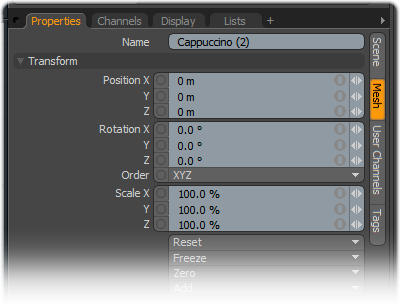
Directly below the Item and Shader Tree lists section are more lists. As scenes fill up with items and textures, UV maps and such, a serious amount of information is created along with it, and Modo offers many ways of viewing and manipulating all that info. In this group of lists, Properties is the most important. It is useful to keep this open most of the time.
The first tab across the top is the main item Properties tab. Every item in Modo has a series of attributes associated with it, and this is the viewport where you can edit them. Selecting any item displays the item's properties, dynamically changing as different types of items are selected.
The next tab is Channels. Every animateable attribute of an item is listed here for easy view, selection and manipulation. For more information on the Channels tab, see Channels Viewport.
The Display tab controls the visibility and display of items within the 3D Viewport. For more information on this tab, see Display Viewport.
The next tab, Lists, consists of three parts. The top section lists all the associated Vertex Maps. A Vertex Map is an instruction associated with a vertex telling it to do a certain thing, such as move a specific offset distance (morph map), specify a 2D position on an image (UV) or simply a value that is fed into another function such as Weight Maps do. To see the Vertex Map associated to an item, the item must be selected (highlighted in the item list). In this window, you can create, rename and delete any of the various maps.
Under the Lists tab is the Pipeline viewport or Tool Pipe. This is the heart of the Modo toolbox. A tool can be made up from a single function like the Cube tool, or it can be a combination of functions rolled together, such as a transform tool with a certain falloff and action center, like the Flex tool. The Tool Pipe is where you can make custom tool combinations. Presets contains the various pre-made tool combinations included in the various tool boxes that install with Modo.
Below the Pipeline viewport, you can find Statistics. This is a listing of scene statistics: the total number of polygons, how many of them are triangles or have more than 5 sides. You can use the +/- icons preceding each line for selecting and deselecting geometry in the scene based on the specific criteria. Lastly, the Info tab gives you all the information associated with a selection. Selecting an item, provides information on that item. Selecting some geometry provides information on all the associated vertices and map values as well as applied surfaces and selection sets associated with it. For more information on the contents of these tabs, see Info and Statistics.

Modo employs an interface switching option using Ctrl+Tab to quickly switch workspace layouts. Press Ctrl and then Tab to open the selection pop-up. Continuing to hold down Ctrl and then release and press Tab again to cycle to the next workspace highlighted by the orange outline. Subsequent Tab presses continue to cycle through the selections organized by the layout's most recent use. Releasing the keys opens the currently selected interface. This method eliminates the space used by the tabs in the interface. This option is also available from the menu bar, in Layout > Recent Layouts.... Specific layouts are accessible from the menu bar under Layout > Layouts. Each of the various workspaces is covered in more details below. Additionally, you can access the pie menu version of the layout switcher by pressing Ctrl+ ~ (tilde).

The Animate tab focuses specifically on animation, especially refined for character work. This viewport is unique in that the standardized layout is gone, in order to maximize the 3D Viewport. Toolboxes have been reduced to pop-up palettes with the essential keying tools laid out as a special toolbox below the Timeline. Hidden just above the Timeline is the Track View that allows you to easily re-time animated elements. To open it, drag the top frame edge of the Timeline upward revealing the hidden viewport. Timeline playback controls run across the bottom of the interface with additional controls for setting keyframes and controlling the auto keying feature with additional easy access to the Channel Sets and Actor/Pose functions. For more information on the Animate viewport, see Animation Interface.
TIP: If you are used to animating in previous versions of Modo, you can use the Layout and Setup interfaces with the more familiar controls.
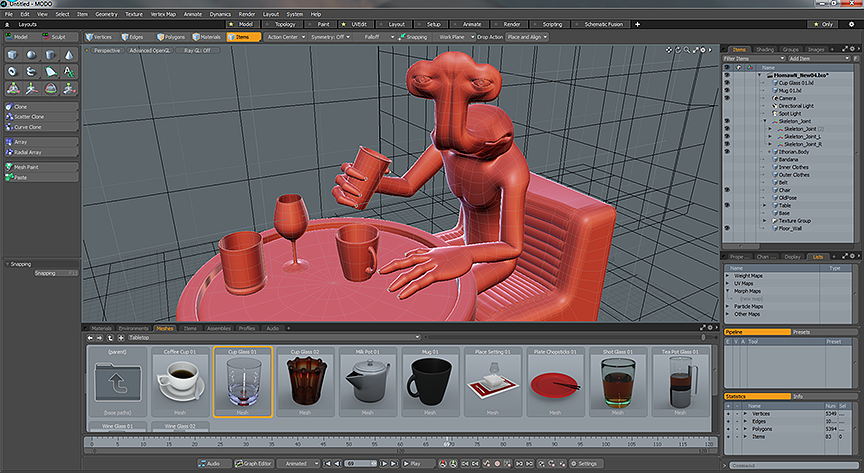
The Layout editor is a useful interface to block out scenes, set up Replicators and instances, and generally design the layout of any scene. The Preset Browser dominates the area below the 3D Viewport, providing access to the many preset assets included in Modo for a streamlined workflow. You can drag and drop an item from the preset viewport into the 3D Viewport to populate a scene with anything from environment maps, assemblies, Mesh Items and surfacing presets, for realistic surfacing.
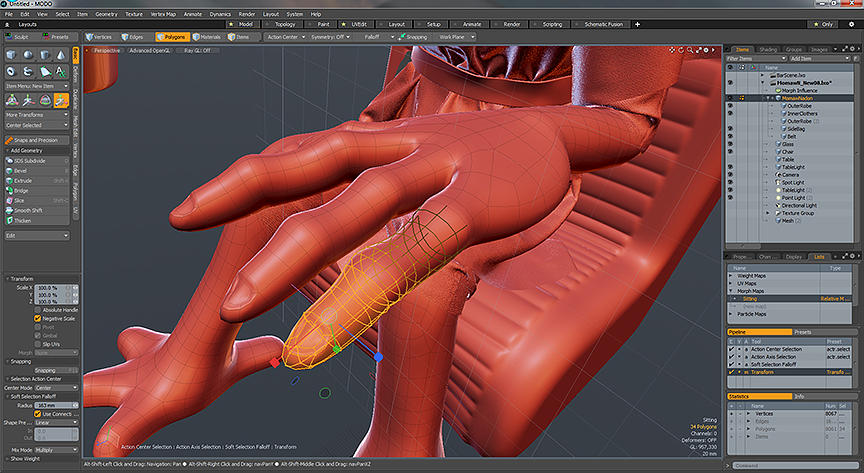
The Model interface is the dedicated model creation space, with all the creation and deforming-specific tools close at hand in the Toolbox on the left side. Below the Toolbox is the standard tool Properties panel. The middle section is the maximized 3D (OpenGL) Viewport, where you can interact with the tool handles and selected geometry. The right side panel contains all the lists viewports: the Item List for selecting item layers in a scene, the Lists viewport with access to Vertex Maps, the Pipeline for customizing tools, and finally the Statistics viewport that allows statistical selections based on component features.
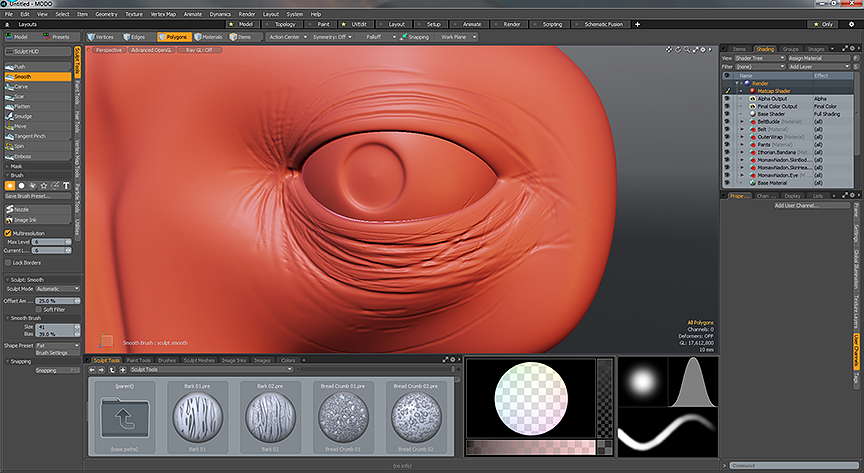
The Paint interface tab focuses on painting and sculpting. The left Toolbox is separated into the various tools and controls for painting textures and sculpting meshes. Directly below the 3D Viewport is located a Preset Browser for viewing brushes and preset tool options. You can also directly access a Color Picker viewport and see the details of the current brush tip in the Tip View window.
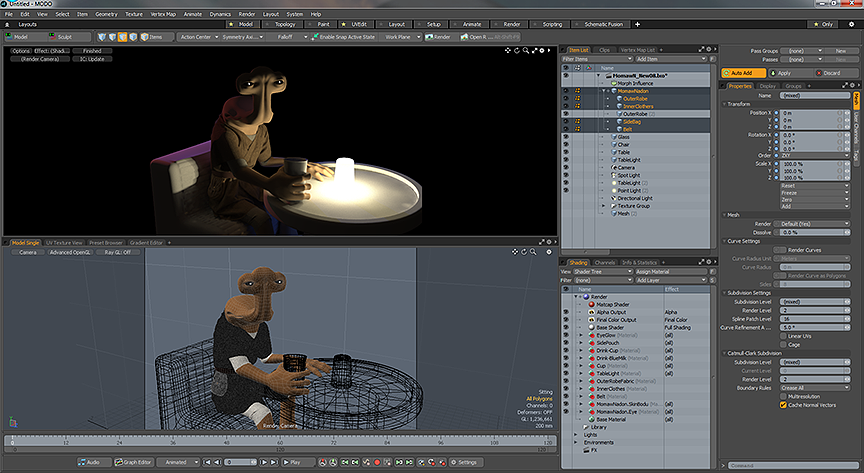
The Render layout provides streamlined access to the main options you need when focusing on the task of rendering a project. On the right-hand side is the Item List and Shader Tree panels, stacked with a tall Render Properties panel, so you can easily access and edit the various material and texture items and settings. The main 3D workspace is split into two views; a Preview Viewport that provides an extremely fast near final preview of the rendered scene, and a Camera View providing direct control over the positioning of the camera. To render in this view, press F9 or select the Render command from the Render options of the menu bar.
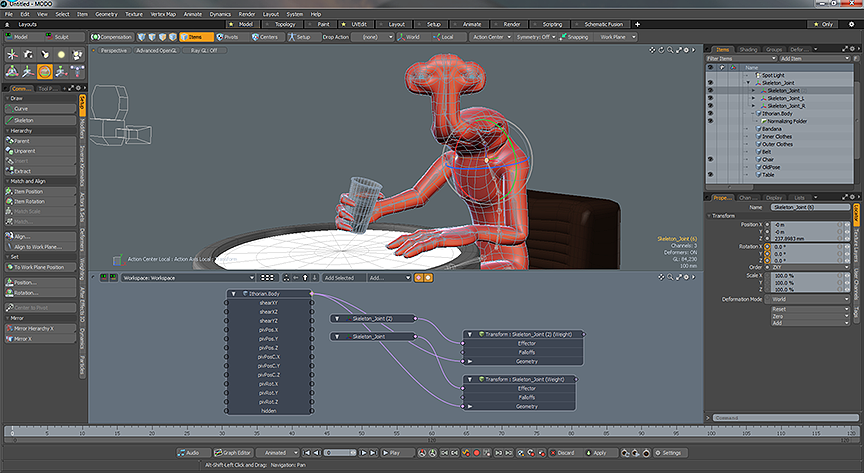
The Setup layout is mainly designed for rigging using the Schematic Viewport. You can select items in the Items list and Shader Tree, grab their associated channels in the Channel list and drag them into the Schematic View for node linking. The Toolbox also offers commands related to channel links and modifiers. Additionally, this is the place for setting up dynamics and particle simulations.
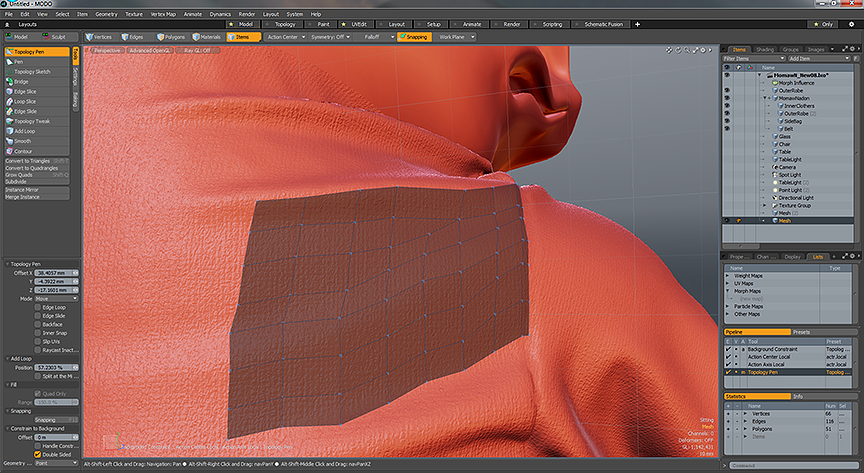
The Topo interface tab contains all the retopology related tools. Retopology is the act of taking a very dense (high resolution) mesh and using its surface in the background as a constraining surface to build a clean, lower resolution mesh. This is a common task when creating game assets where low polygon counts are a requirement, also when cleaning up scanned mesh data for animation, or when simply making it easier to change the topology and polygon flow of an existing model. The Toolbox contains tools that automatically conform to any item in the background, with a special OpenGL drawing mode to make it easier to see what is being drawn in the foreground over what is located in the background.
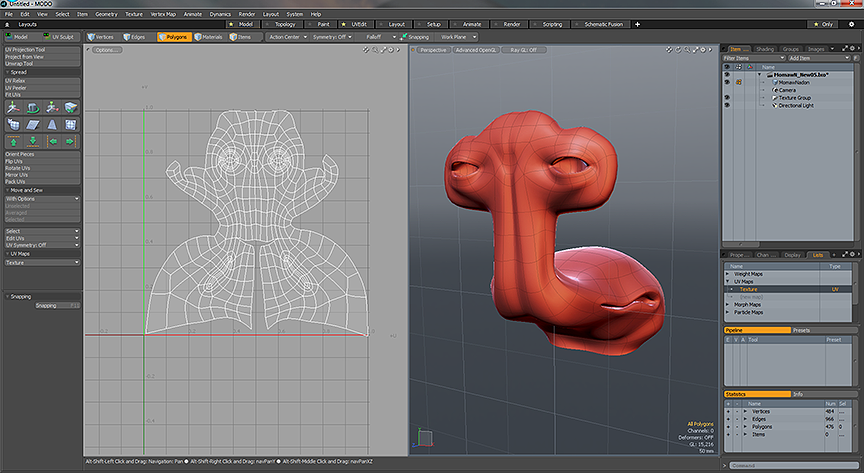
The UV interface splits the 3D Viewport vertically adding a UV View on the left. You can select from the various maps in the Vertex Map list on the right hand side. The Toolbox focuses on the various UV Mapping and editing tools.